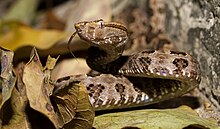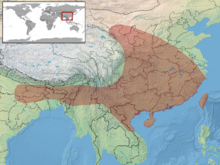
Trimeresurus is a genus of pit vipers found in Asia from the Indian Subcontinent throughout Southeast Asia, China, and the Pacific Islands. Currently 44 species are recognized. Common names include Asian palm pit vipers, Asian lanceheads, and green pit vipers.
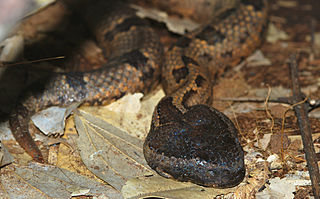
Ovophis monticola, commonly known as the Chinese mountain pit viper, is a pit viper species found in Asia. Currently, two subspecies are recognized, including the nominate subspecies described here. Recent taxonomic work suggests that most of these should be considered as separate species. IUCN has already evaluated O. m. makazayazaya as Ovophis makazayazaya.

Protobothrops jerdonii, also known commonly as Jerdon's pit viper, the yellow-speckled pit viper, and the oriental pit viper, is a species of venomous snake in the subfamily Crotalinae of the family Viperidae. The species is native to India, Nepal, Myanmar, China, and Vietnam. Three subspecies are recognized, including the nominate subspecies described here.

Trimeresurus albolabris, the white-lipped pit viper or white-lipped tree viper, is a venomous pit viper species endemic to Southeast Asia.
Trimeresurus cantori, commonly known as Cantor's pit viper or Cantor's pitviper, is a species of venomous snake, a pit viper in the Subfamily Crotalinae of the family Viperidae. The species is endemic to the Nicobar Islands of India. It was named after Theodore Edward Cantor (1809-1860), a Danish naturalist serving as a surgeon with the East India Company in Calcutta. No subspecies are recognized as being valid.

Trimeresurus erythrurus, commonly known as the red-tailed bamboo pitviper, redtail bamboo pit viper, and redtail pit viper is a venomous pit viper species found in South Asia and Myanmar. No subspecies are currently recognized.

Craspedocephalus gramineus, known as the bamboo pit viper, Indian green pit viper, or common green pit viper, is a venomous pit viper species found in the southern and north eastern parts of India. No subspecies are currently recognized.
Trimeresurus labialis, commonly called Nicobar bamboo pit viper, is a venomous pit viper species endemic to the Nicobar Islands of India. No subspecies are currently recognized.

Craspedocephalus macrolepis, commonly known as the large-scaled pit viper, is a venomous pitviper species endemic to the Southern Western Ghats of South India. No subspecies are currently recognized.

Trimeresurus popeiorum is a species of venomous pit viper in the family Viperidae. The species is native to northern and northeastern parts of India and Southeast Asia. Common names include: Pope's pit viper, Pope's green pit viper, Pope's tree viper and Pope's bamboo pitviper.

Trimeresurus purpureomaculatus is a venomous pit viper species native to India, Bangladesh and Southeast Asia. Common names include: mangrove pit viper, mangrove viper, and shore pit viper.

Trimeresurus septentrionalis, commonly known as the Nepal pit viper or northern white-lipped pit viper, is a venomous pit viper species found in Bangladesh, Bhutan, Nepal and India.

Trimeresurus stejnegeri is a species of venomous pit viper endemic to Asia. Two subspecies are currently recognized, including the nominate subspecies described here.

Ovophis okinavensis, commonly known as the hime habu (ヒメハブ), Ryukyu Island pit viper, and the Okinawan pitviper, is a pit viper species found in the Ryukyu Islands of Japan. No subspecies are currently recognized.
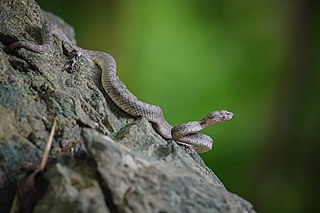
Trimeresurus kanburiensis is a species of pit viper found in only a few areas of Thailand. Common names include: Kanburi pitviper, Kanburian pit viper, and tiger pit viper. Highly venomous, it is an arboreal but heavily built species with a brown or tawny coloration. No subspecies are currently recognized.

Craspedocephalus puniceus is a venomous pit viper species endemic to Southeast Asia. Common names include: flat-nosed pitviper, flat-nosed pit viper, and ashy pit viper. No subspecies are currently recognized.
Protobothrops kaulbacki, commonly known as Kaulback's lance-headed pit viper or Kaulback's lance-headed pit viper, is a pit viper species endemic to Asia. There are no subspecies that are recognized as being valid.

Trimeresurus gracilis, commonly known as the Taiwan pit viper or Taiwan mountain pitviper, is a venomous pit viper species endemic to Taiwan. No subspecies are currently recognized. The species is known as kikushi habu in Japanese.
Garthius chaseni, commonly known as Chasen's mountain pit viper, Chasen's tree viper, and the Kinabalu brown pit viper, is a species of pit viper in the family Viperidae. The species is endemic to the island of Borneo in Malaysia. No subspecies are currently recognized. It is monotypic in the genus Garthius.
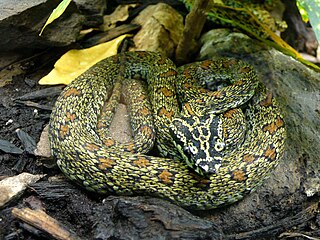
Protobothrops jerdonii xanthomelas is a venomous pit viper subspecies endemic to China.
